Lineage-splitting and extinction have taken place often throughout the history of life — they are not rare, one-time only events. That means that if scientists have a lot of information about a clade, they can calculate its rate of extinction or the rate of lineage-splitting (known as the rate of diversification).
The balance between a clade’s rates of diversification and extinction determines whether or not the entire clade will go extinct. If, for example, your school’s yodeling club is losing members faster than it can bring them in, it won’t be around for long.
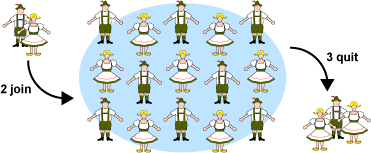
The same processes operate on a clade’s diversity: if extinction happens more frequently than lineage-splitting, that entire clade will go extinct eventually. For example, trilobites and ammonites had high rates of both diversification and extinction.
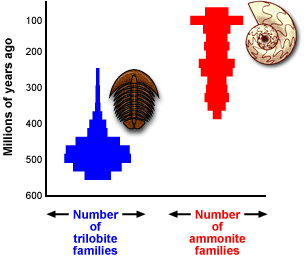
That means that looking back in the fossil record, we see many different trilobite and ammonite lineages, but few that lasted for long periods of geologic time. And of course, for both of these clades, in the long run, extinction happened more frequently than lineage-splitting, with the result that both are now entirely extinct.
Understanding rates of extinction and diversification also gives us a new way to look at diversity. For example, a clade might be large because it is generating new members (high rate of diversification), or it might be large because it rarely loses members (low rate of extinction).
 Digging Data
Digging Data
Most of the food we eat every day is grown or raised specifically for that purpose. Wheat is planted so we can have bread, orchards watered to provide fruit, chickens raised for meat and eggs. However, with seafood, it’s a different story. Much of what’s available at the seafood counter is pulled directly from the wild. You may already know that overfishing takes a huge toll on these populations, threatening many with extinction. For example, the Southern Bluefin Tuna, a sought-after delicacy in Japan, is classified as an endangered species. The problem is so big that initiatives such as Seafood Watch have been launched to educate people and encourage sustainable practices in the seafood industry.

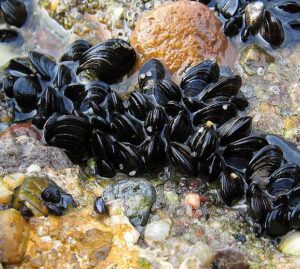
But what about the less flashy (and fishy) staples of seafood counters? Bivalves – mollusks with two shells, like clams, scallops, oysters, and mussels – are not as charismatic as a tuna or swordfish but are vital to marine ecosystems. They filter and clean water; they serve as food for other animals; they store carbon; and their reefs help protect shorelines from erosion and flooding, and can provide “nurseries” for other marine life. Are conservationists so focused on restoring crashing fish populations that threatened bivalves are being overlooked?
Scientists and policymakers don’t know much about bivalves as a food source. Until recently, we haven’t done a good job of keeping track of which species are being harvested and how much we are taking – let alone checking in on the health of wild populations. There are more than 6000 species of bivalve living in the shallow waters of the world’s oceans, and for less than 50 of those have we even considered whether they are nearing extinction.
Directly assessing the risks to the 800 species of mollusk that provide food for people all over the world would be an enormous undertaking. Paleontologists David Jablonski, Shan Huang, and Stewart Edie, along with a team that included Katie Collins, Nicholas Crouch, and Kaustuv Roy, set out to give conservation biologists an idea of where to start. The team evaluated the traits of mollusk lineages to see if those that we eat have traits that might make them particularly vulnerable or resistant to extinction.
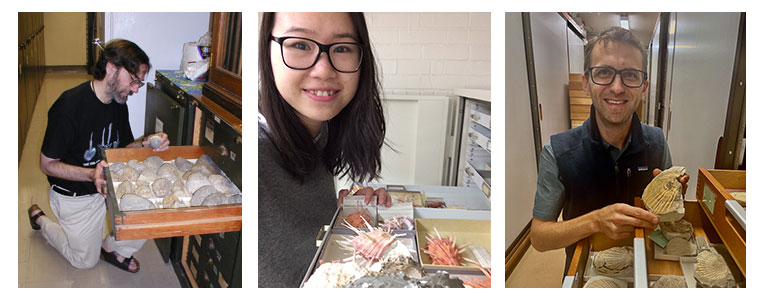
Hypotheses
Biologists have hypothesized that the following traits might make a bivalve species more vulnerable to extinction:
- Small geographic range – If a species lives only in one restricted spot, it’s much more likely that a disaster will wind up killing every individual of the species. However, if a species has a broad geographic range, odds are that, when disaster strikes, somewhere, some individuals will survive and can replenish the population.
- Small temperature range – If a species can only tolerate a narrow temperature window, it is unlikely to survive as the Earth rapidly warms (as it is now) or cools (as it has many times in the past). Even short-term extremes, like a really bad summer month, can be lethal. Change is inevitable, so a species that can live in a wide range of temperatures has a big advantage for avoiding extinction. One might think that having a small temperature range would always be tied to having a small geographic range, but in fact some species with narrow temperature ranges have a broad geographic range because there are many places at that preferred temperature.
- Lots of extinction among close relatives – Just as feeding habits and shell structure are passed down from ancestor to descendent, so too it seems is vulnerability to extinction. If a species belongs to an evolutionary group – a family – that has experienced a lot of extinction in the past, that species is more likely to go extinct in the future. The researchers called this overall estimate of how sensitive a species is likely to be when faced with environmental changes volatility. Mollusk families with high volatility contain many lineages that have gone extinct over Earth’s history and are known only from their fossils.
Many prior studies have shown that these hypotheses are good ones – that mollusks with small geographic and temperature ranges and high volatility are more vulnerable to extinction than others. But the team wasn’t sure how these three traits would sort out among mollusk species. They hypothesized that having larger geographic and temperature ranges would make a mollusk species more accessible to more people, and so make it more likely to be selected as a food source. However, there was no reason to suspect that harvested mollusks would come from families that were particularly extinction prone or extinction resistant.
Data
By scouring the research literature, the scientists assembled a database of more than 6000 bivalve species, for each noting the size of its geographic range, its temperature range (i.e., the complete range of temperatures the species experiences in all the places it lives), and the extinction rate within its evolutionary family. These three factors can all affect a species’ vulnerability to extinction, but of course, they don’t always sync up. How would the team compare, for example, a species with a large geographic range from a family with lots of extinction to a species with a narrower range but from a family with little history of extinction?
To address this problem and provide an overall picture of extinction vulnerability, the researchers combined all three factors into a single score that they called PERIL (for Paleontological Extinction Risk In Lineages). PERIL scores take a little math to calculate, but all you need to know to understand them is that geographic range, temperature range, and extinction history are all weighed equally in the score and that higher PERIL scores mean higher vulnerability to extinction.
When the team mapped out the different variables and compared bivalve species we eat to those we do not, they saw some interesting patterns:
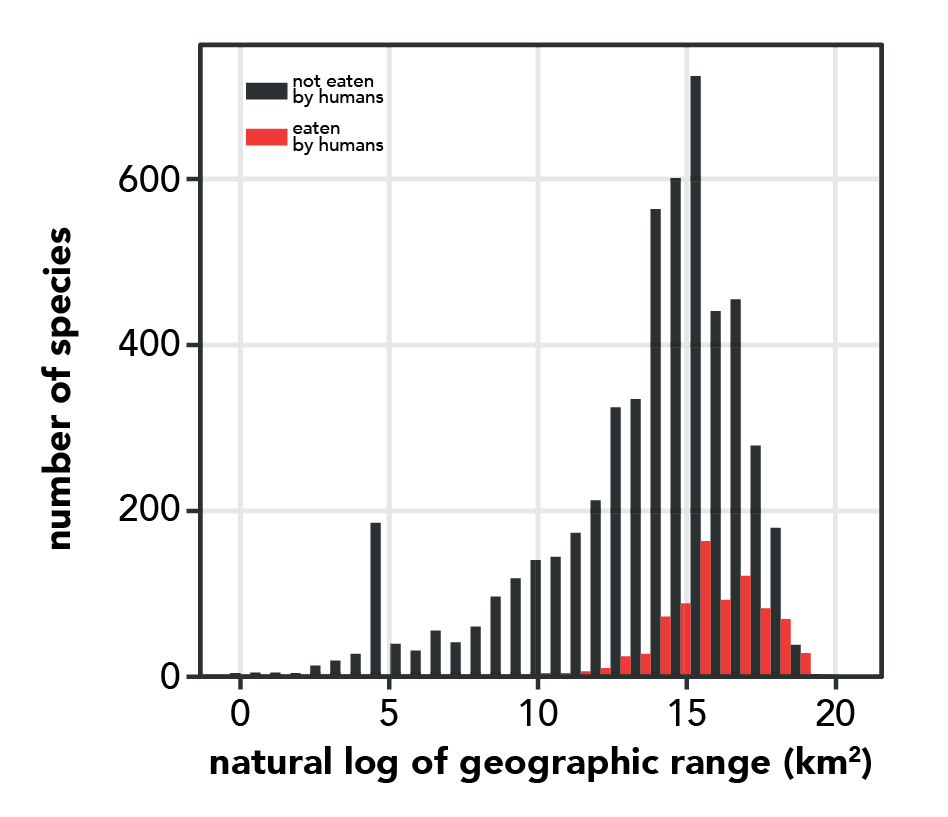
This graph shows the different geographic range sizes of bivalve species that we eat versus those we do not. Because a few species have very large ranges, the researchers took the natural logarithm of the geographic ranges to make patterns in the data easier to see and work with. This transformation changes the magnitude of each data point but keeps the relationships among data points the same (e.g., the largest raw number is still the largest after taking the natural log).
It’s clear from this graph (and its much longer black bars) that there are lots more uneaten than eaten species. But does one group tend to have larger geographic ranges than the other? Range size is shown on the x-axis. You can see that the red bars of the eaten species fall more towards the high end of the geographic ranges (i.e., shifted towards the right side of the graph). Statistics can tell us whether that difference is likely a meaningful pattern or one that could easily be due to chance alone.
The team performed a Kolmogorov-Smirnov test, which calculates the likelihood that two samples come from the same underlying distribution (i.e., are statistically “the same”). The p-value was less than 0.001, indicating that less than one tenth of one percent of samples drawn from the same distribution would differ by this much or more just by chance alone. The usual cut-off for a significant difference is 5% maximum, so this is a very significant result. It appears that mollusk species that we eat really do tend to have larger geographic ranges than those we don’t eat. This makes sense and supports one of the team’s original hypotheses. Bivalve species with larger ranges are likely to be easier to find in many places and could become a diet staple.
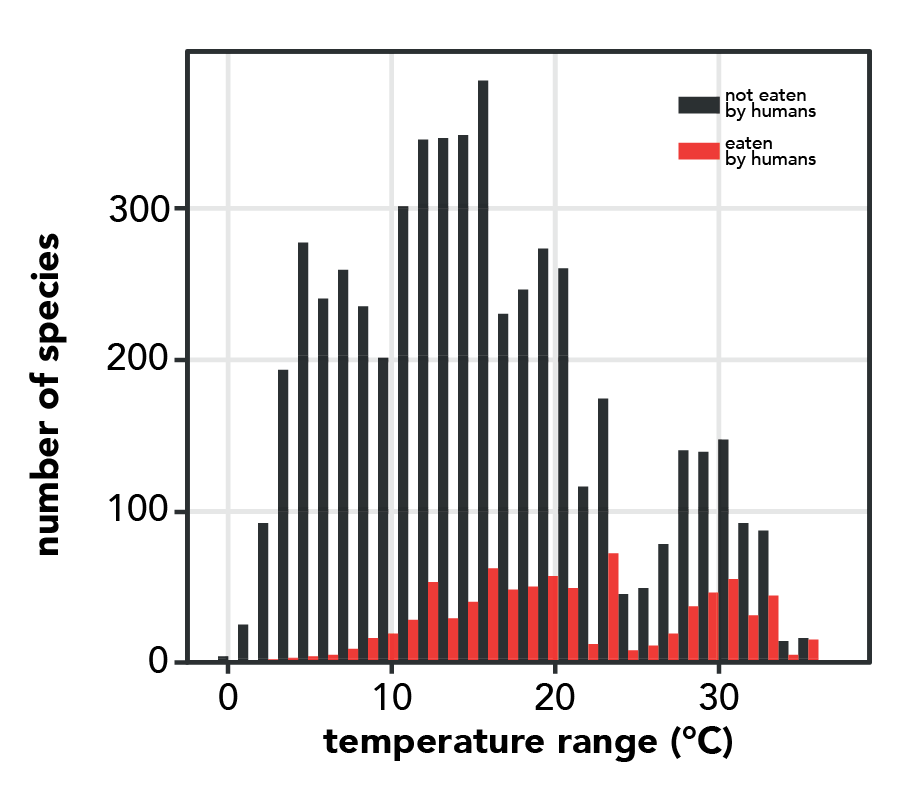
This graph shows the different temperature ranges of bivalves that we eat versus those we do not. Again, you can see that the red bars of the eaten species are positioned more towards the high end of the temperature ranges (i.e., shifted towards the right side of the graph). And this difference is also significant with a p-value less than 0.001, even stronger support for one of the team’s original hypotheses. Bivalves that we eat tend to be able to live at a wider range of temperatures compared to species we don’t eat. That is somewhat reassuring news given the current warming of the planet.
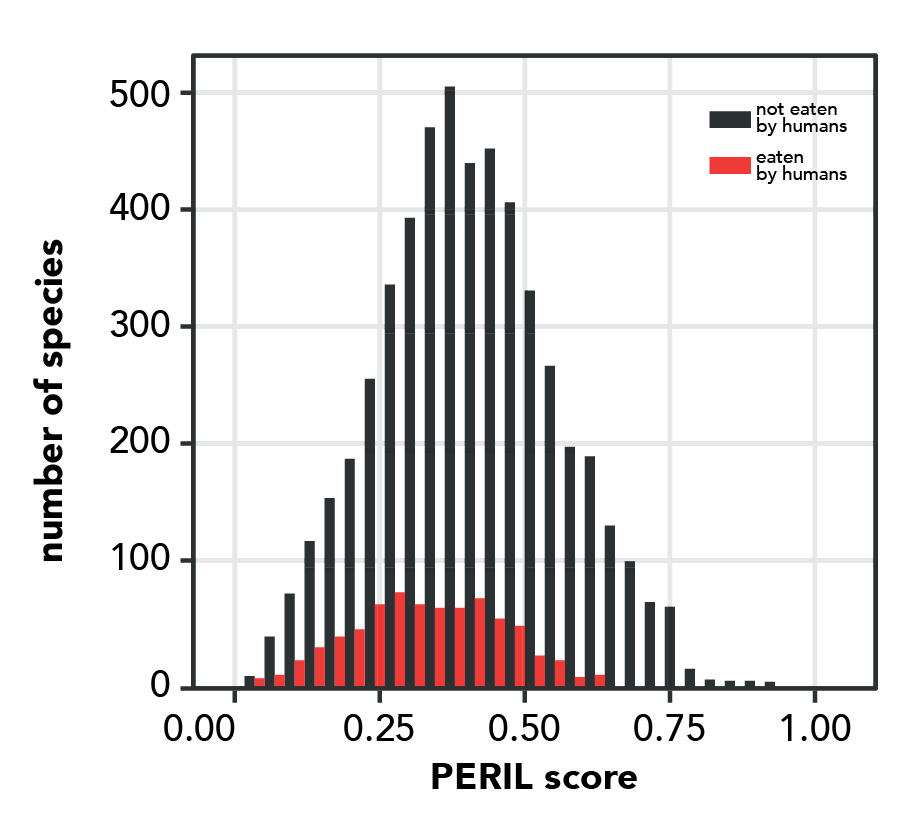
Adapted from Huang et al. (2023).
Finally, this graph shows PERIL scores, which indicate how vulnerable a species is to extinction overall by incorporating its geographic and temperature ranges, as well the volatility of that species’ family (i.e., how much extinction has happened in the species’ closest relatives). The difference between the eaten and non-eaten species is less noticeable here, but you can probably see that, on average, species that are used by humans as food tend to have lower PERIL scores (i.e., they are shifted towards the left side of the graph). This difference is also statistically significant with a p-value less than 0.001.
In a rare bit of good environmental news, the evidence suggests that, on average, bivalves that we eat are somewhat resistant to extinction in comparison to other mollusks.[1] That fits with recommendations from Seafood Watch, which rates most bivalves as best or second best choices for seafood, with just one (Eastern oysters caught in New York) listed as an option to be avoided. However, the research also highlights clear exceptions to the overall trend, where harvested species are particularly vulnerable to extinction. For example, the Muar oyster (Crassostrea saidii, purported to be quite tasty!) has a high PERIL score and is found in just one estuary in Malaysia – where it could be wiped out by a single event upstream, like a chemical spill or mudslide.
Many species of scallop also have notably high PERIL scores. With this new information, conservationists can focus their investigations on the species and groups that have higher vulnerability to get a sense of their real-life extinction risk. How big are their populations? How much are we harvesting? How will they be affected by further climate change? And do any of these at-risk species perform essential roles in their ecosystems? With this information we may be able to intervene before they go the way of the passenger pigeon, harvested all the way to extinction.
Stepping into science
David, Shan, and Stewart came to science via different routes. David grew up in New York City where museums and dinosaur fossils inspired his first interest in science. As a child, Shan was drawn to her science classes and liked to spend her free time solving puzzles and devouring stories though books and movies. And Stewart started off mucking about in rivers and marshes – until a high school science teacher helped him see these wild playgrounds as a biologist would, as complex webs of interacting organisms and processes.
Now, all three scientists are united by a shared curiosity about one of the biggest questions in biology: what controls the number and kinds of different species on the planet? Yet their different childhood passions are all present in their work today. David spends much of his time working with data from the museum collections that first inspired him. Shan feels like she’s following a story through her research: “I really like detective stories, and jigsaw puzzles, and I feel like a detective when I look at data and try to deduce some theories out of them.” And Stewart’s focus has shifted from frolicking in muddy marshes to understanding such ecosystems over deep time – but his feelings about scientific research still sound like those of a kid on a playground: “It’s a blast!”
[1]Of course, this research is based on extinction patterns over Earth’s deep history – most of which was free from human influence, since we simply weren’t around. Whether or not species with low PERIL scores are likewise resistant to extinction from the onslaught of human-induced changes they now face (overfishing, land-use change, pollution, rapid ocean acidification, etc.) is not a sure thing. Nevertheless, the finding that mollusk species that we eat have some properties that protected them from extinction in the past seems reassuring at least when compared to what the researchers might have found – that harvested species have traits that have made lineages more vulnerable to extinction in the past.
Teachers can use the following resources to build a lesson sequence around mollusks, overfishing, and extinction for the high school and college levels.
- A 13-minute video introducing David Jablonski’s work on extinction vulnerability in mollusks
- Student reading with comprehension questions
- Student reading with comprehensions and data interpretation questions
- The original journal article explaining this research
- Reading assignment with essay questions on phylogenetic conservation of extinction risk
- 2-3 hour lab or project in which students analyze data on mollusk extinction patterns during the K-T mass extinction, which includes a set of slides introducing mollusks and extinction risk
- A research profile on David Jablonski’s work on extinction risk, along with discussion questions
- An interactive, online module on the balance between lineage-splitting and extinction
For answer keys to the two student reading worksheets above, teachers can email UEkeys@berkeley.edu from a school email address and must be verifiably employed as an educator at that school.
In this high school and college-level article (and the linked assignments and student readings), students examine and interpret data that Melissa Kemp and Liz Hadly used to study extinction bias in Caribbean lizards:
The following Data Nugget activities for middle and high school students offer students opportunities to analyze data on extinction risk in other animal systems:
Read more about:
- Huang, S., Edie, S. M., Collins, K. S., Crouch, N. M. A., Roy, K., and Jablonski, D. (2023). Diversity, distribution, and intrinsic extinction vulnerability of exploited marine bivalves. Nature Communications. 14: 4639.
Learn more about the balance between lineage-splitting and extinction in context:
- Where species come from, a news brief with discussion questions.
